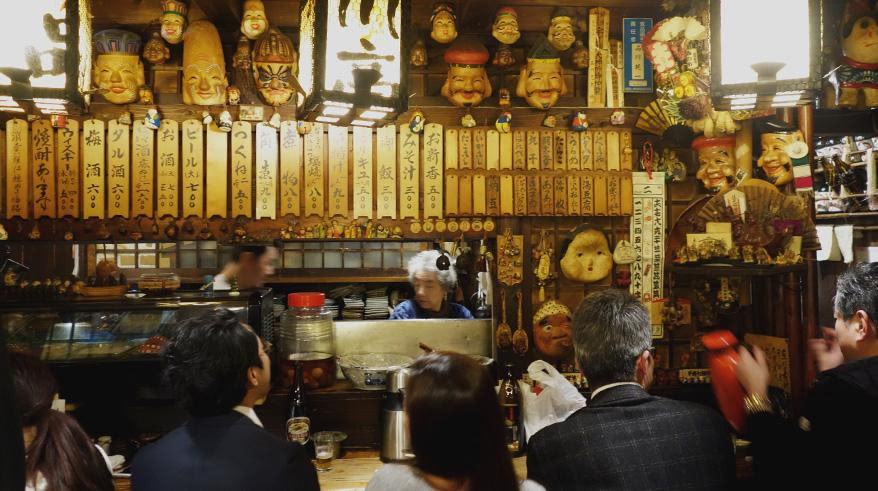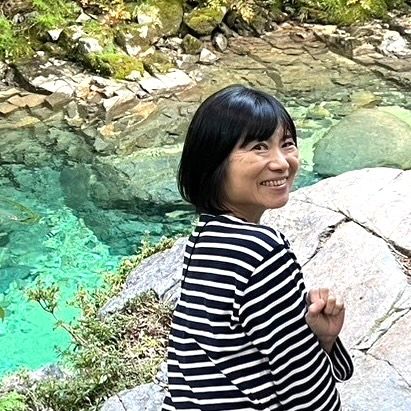私たちは時間を忘れ飲んで食べて話し込んでいた。
店内はこじんまりと居心地がよい。ここは新宿中央公園のすぐ近く、再開発の手を逃れた一角にひっそりとある小料理屋、というか「酒場」である。
西新宿の隠れ酒場で放浪記することになった
品川亭。写真で見た感じは、古くて、かなり雰囲気のある飲み屋のようだ。私はこの店を GoogleMap で偶然見つけた。行ってみたい店としてマップ上にマークはしていたのだが、西新宿という立地もあって実際に行くチャンスは無かった。仕事終わりにちょっといこうよ、というにはモノサスからも新宿駅からも離れている気がしていた。
モノサスから歩いて18分・・・それでも編集長中庭に店のことを話してみたら、ぜひ行ってみましょう、と彼女の目がキラリと光った。同じく編集部の大村は「吉田類の酒場放浪記」の大ファン。このお店、番組で見たことあります~!!と大興奮。あの類さんも訪れた店ならば行くしかあるまい、と一気に盛り上がったわたしたちは、さっそく金曜日の夜に品川亭女子会を設定することとなった。
席が少なそうなので、念のため予約を入れることにした。電話をかけると女将さんが出て「3人なら小上がりをとっておくね」と親切に応対してくれた。"こあがり"の語感がすでに酒場放浪記・・・とニヤニヤしてしまう。電話越しに女将さんの感じの良さが伝わってくるし、行くのが待ち遠しくなってきた。前日たまたまクリエイティブ部の道場に声をかけてみると案の定「行く」、という。そこで彼女を加えた女4人、酒場に放浪することとなった。
注:小上がり(こあがり)・・・小料理屋などで椅子席と通路をはさんで設けられた座敷のこと。
外から見ても、中に入っても江戸風情。
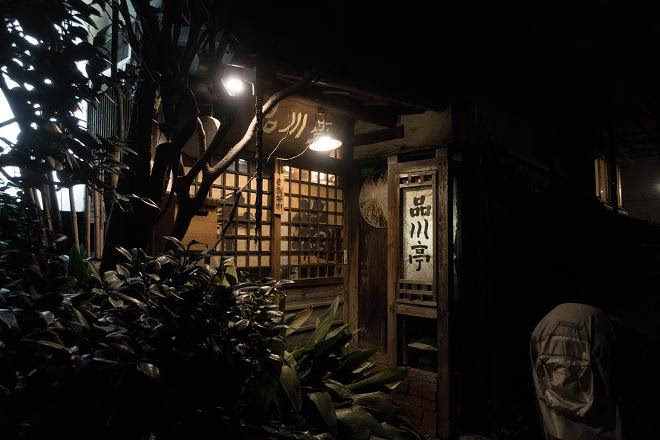
暗闇に品川亭の明かりが灯っている。昭和を通り越して江戸時代のようだ。
その日、仕事を終わらせた私たちはそろって会社を出た。2月の寒い夜に18分も歩くつもりはさらさらなく、西参道の大通りまで出てタクシーを拾う。5分とかからない距離で、都内初乗り運賃値下げの恩恵をさっそく受けてしまった。410円で行けたのはありがたい。
タクシーを降りた場所は熊野神社交差点の手前。マップをたよりに入った道は暗く、空き地とビルしかない。ほんとにこんな場所にあるのかな?と思いはじめたところで、街灯の下に品川亭・赤矢印の看板が煌々と光っているのを見つけた。その角を曲がるとすぐに店はあった。うわ!すごい・・・。品川亭が時代劇のセットみたいに闇に浮かんでいた。
歴史ありそうな店構えに緊張しつつ、ガラガラ。と格子の引き戸を開ける。すぐ目の前にお客さんの背中がせまっていた。第一印象は、とにかくコンパクトな店内。
すべてが小さくぎゅっと詰まっている。カウンター席についているお客さんを見ると、予想に反して年齢層はいろいろ。渋いお父さんが静かに飲む店だったら私たち浮いてしまう・・・という心配は消えた。
予約しておいた小上がりは女性4人がちょうど収まる広さである。すっぽりはまった感じで落ち着く。ふと目をあげると、カウンター席のはずれで吉田類さん(のポスター)が微笑んでいた。ほんとに酒場放浪記がロケに来たんだねぇ・・・大村と共に静かに感動を分かち合った。
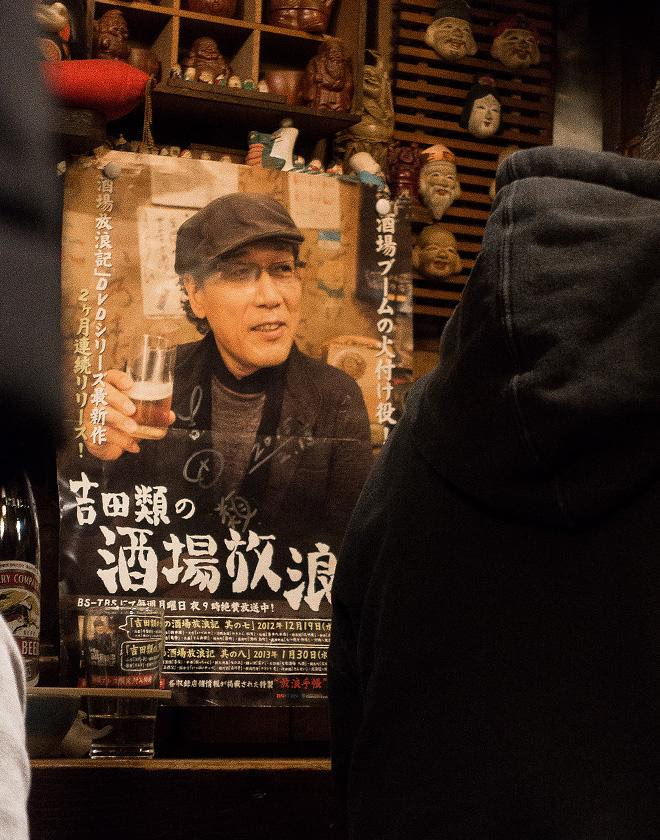
吉田類さんのポスターを発見!
それにしても圧倒されたのは壁を埋め尽くす七福神。七福神のお面や人形、写真、色紙などが隙間がないほどに飾られている。あるお客さんがお店にプレゼントしたのがきっかけで、他のお客さんも次々と七福神をもってくるようになったという話だった。お店に奉納しに来ている気分なのだろうか。
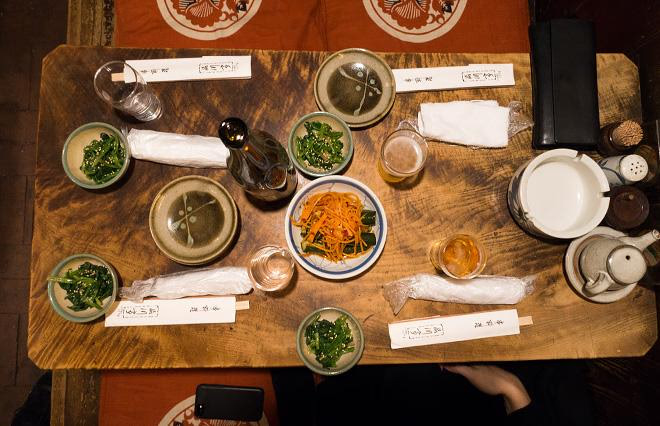
小上がりの4人席。小さな座卓を囲んで話がはずむ。中央にあるのがピリキュ。
念願の小上がりにおさまって、さっそく瓶ビールと「ピリキュ」を注文。キュウリのうえに人参の細切りがのっているナムルっぽいお新香。唐辛子がきいているからピリキュ。あとは壁にかかった品書きの札から食べたいものをつぎつぎ頼んでいく。つくね(わさびで食べる)、厚揚げ、豚バラ角煮(全員同意のイチオシ)、うるめ・・・どれも王道のおつまみだけど、一品一品材料を吟味して丁寧に作られているのがわかる味。
御年80歳になる女将さん、まだまだ現役である。
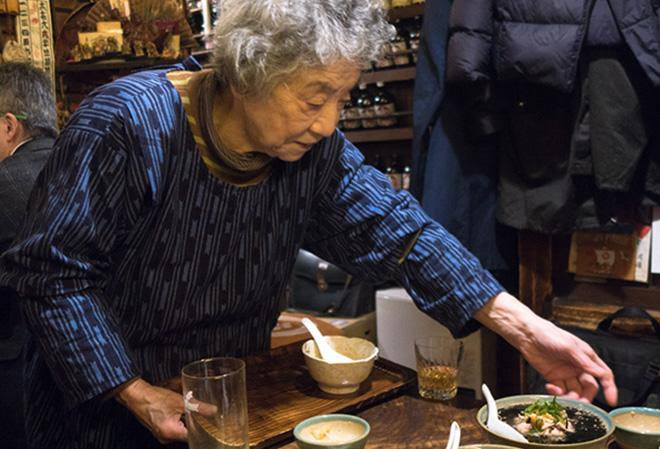 ハキハキしたおしゃべりと、さりげない心配りで、じんわりとうれしい気持ちにさせてくれる女将さん
ハキハキしたおしゃべりと、さりげない心配りで、じんわりとうれしい気持ちにさせてくれる女将さん
通路に立って注文をとるのは女将さん。実にてきぱきとされている。ビールとグラス、お通しをぱぱっと並べる。メニューによって、これは4人分にしておく?などと確認しながら注文をとってくれる気遣いにも安心する。しばらくしてからお歳をうかがってびっくりした。
80歳になるという。なんてお元気なんだろう!驚愕する私たち。もし自分がおばあちゃんになったときは女将さんのようにシャキッとしていたいなぁ・・・。話し言葉もくっきりリズムよく、明るい。初めて来た私たちにも気さくに話をしてくれるのである。ますます居心地がよい。
途中トイレに立ったとき、窓枠に大豆が置いてあるのに気づいた。3粒ちょこんと静かに並んでいる。そういえば今日は節分だった。なんと奥ゆかしい豆まきだろう。女将さんがそっと豆を置いている姿が想像され、ほっこりした気持ちで席に戻った。
トナリとの距離がとにかく近い。
自然に生まれる会話
小上がりの机は小さくて全員の顔が近く、なんだか話がしやすい。そしてこの店では通路をはさんでカウンターのお客さんとの会話も自然にうまれる。おたがいの会話が聞くともなしに耳にはいってくるからだろう。私たちが地ビールの話で盛り上がっていたとき、カウンターの二人連れの男性が「そのビールって・・・」と、話に参入してきた感じもいっしょに来ている同僚みたいだった。
美味しさと匂いのせめぎあい
人生初の「くさや」
ビールを終えて、次に自家製の梅酒を注文してみた。琥珀色が濃く、甘めで丸みのある複雑な味だ。女将さんによると毎年つくったものを継ぎ足しているそうで、大体3年ものだそうだ。おまけで出してくれた梅酒の梅の実は、ふっくらと柔らかくておいしかった。もらってジャムにするお客さんがいるというのもうなずける。
その梅酒を飲みながら、「くさや?くさやって食べたことないよね」などと壁の品札を読み上げて、ワイワイしていた私たちにカウンターにいた常連らしきお姉さんが話ししかけてきた。「このお店のくさやは大丈夫よ!わたしもココのだけは食べられるの」と強くお勧めされる。話を聞いていてその気になった私たちは、思い切ってくさやを注文することにした。
目の前に置かれた小鉢からは、強烈な匂いがしている。が、見た目は魚の干物。躊躇せずに全員が口に入れた。噛み始めると・・・あれ?最初に嗅いだときより臭くない。不思議だ。なにしろ今日初めて食べたので他と比べられないが、個人的には"濃い干物"という感想である。ご飯といっしょに食べたらいいかもしれない。宴も終盤ということもあってか、半分食べたところで全員の箸がとまってしまった、人生初のくさやであった。
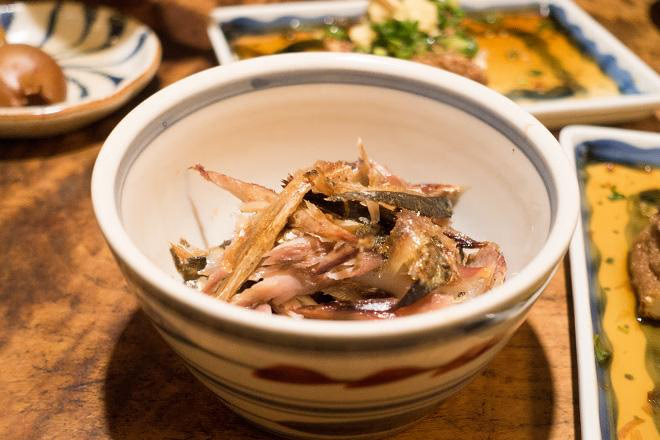
くさや。(例えるなら鶏小屋の匂い・・・)味はよいのです。
本日の〆はお茶漬け。「今日のシャケはすごく辛いやつだけどいい?」と大将がわざわざことわって出してくれたシャケ茶漬け。たっぷり一面の海苔にゴマと青じその香りがきいている。あったかいご飯が胃袋にしみた。ひさしぶりにおいしいお茶漬けを食べた。
そんな感じで最後まで楽しく飲み続けた私たち。女将さん、カウンターの中の大将、店内のお客さんが一体となった本物の酒場放浪記を体験することができた。店内の人々に笑顔で送り出されて外に出る。近いうちにきっとまた来ようと心に決め、皆いい気分で家路についたのであった。
品川亭
東京都新宿区西新宿4-13-13
tel:03-3378-1178
営業時間:
月〜土 17:30~23:30
日祝定休
